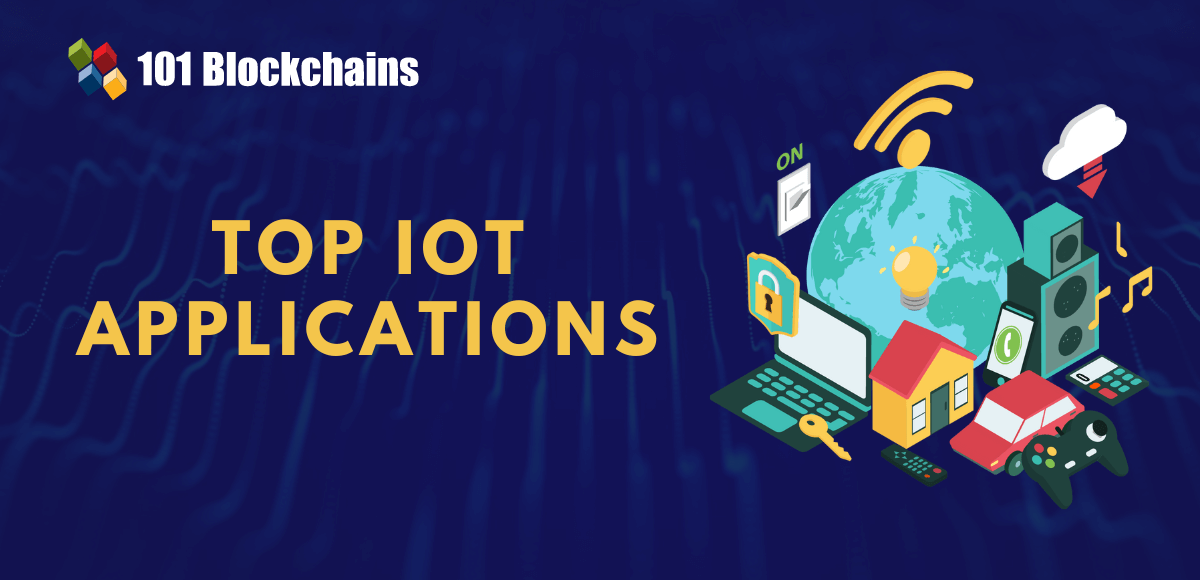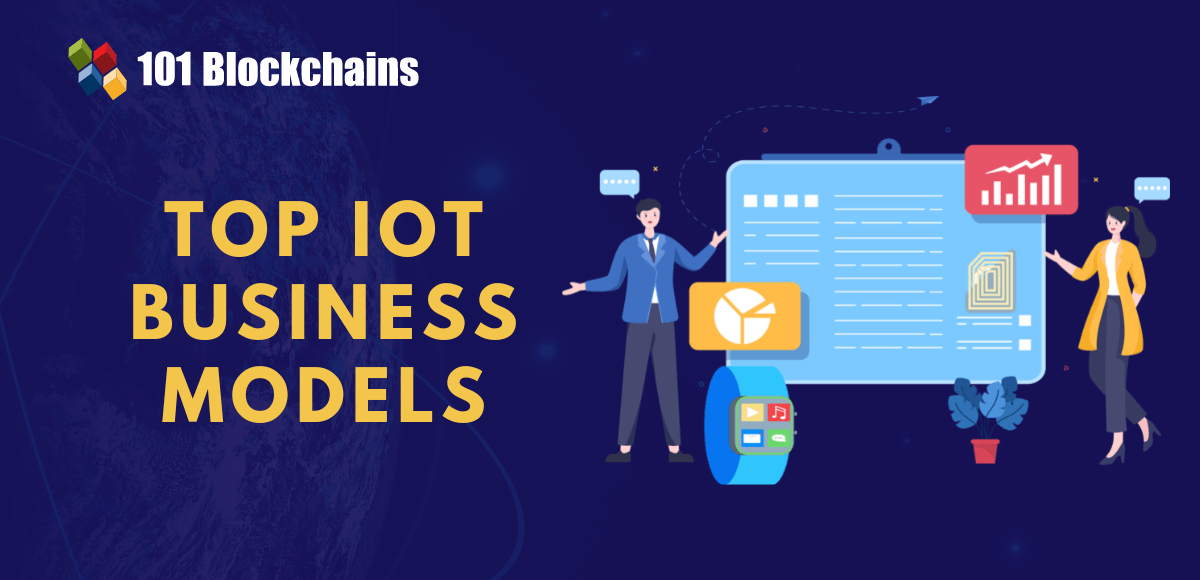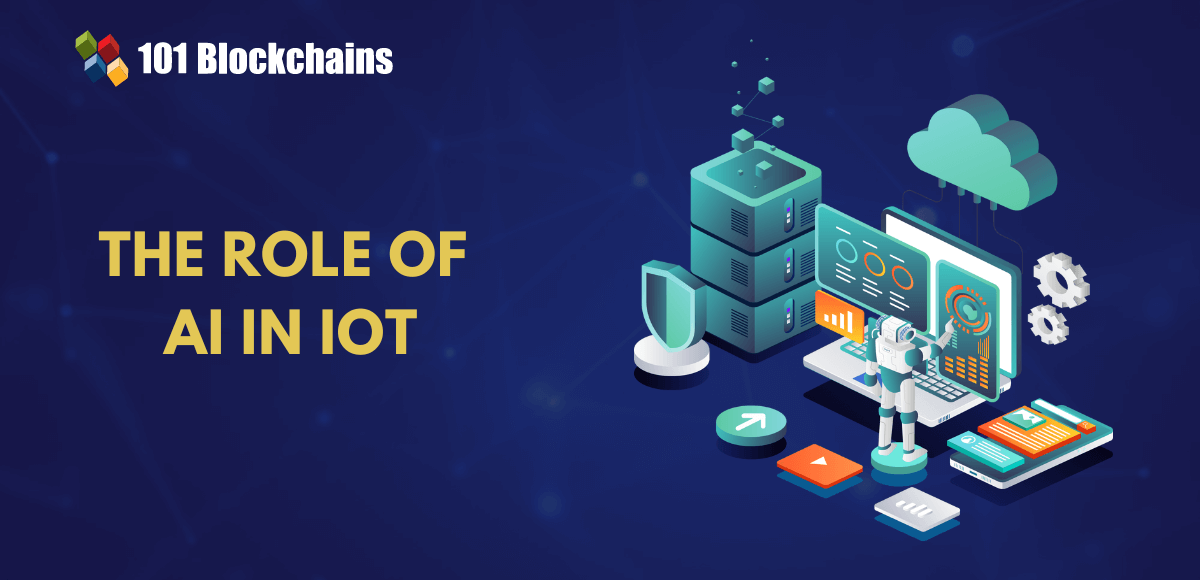Learn how blockchain truly works, master key definitions, and uncover what makes smart contracts so "smart." Dive into the fundamentals, gain valuable insights, and start your blockchain journey today!
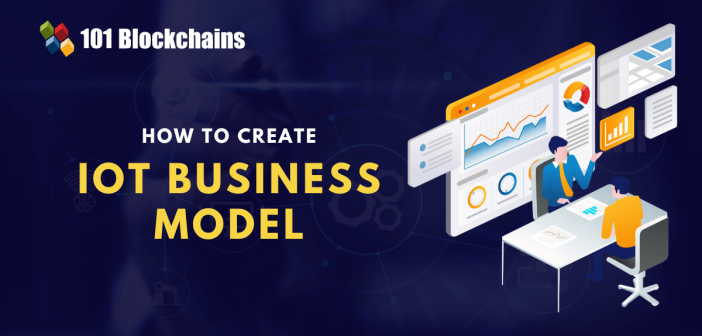
- IoT
Georgia Weston
- on March 29, 2023
How to create a successful IoT business model
The IoT industry can open up the roads for many new value advantages and opportunities for businesses. If you want to learn about best practices to create IoT business model development, you must have doubts regarding IoT adoption. Why are businesses committed to the adoption of IoT in such large numbers? The answer would obviously redirect you towards better efficiency in business processes.
At the same time, cost savings through automation and networking can encourage businesses to adopt IoT solutions. On top of it, the introduction of new service offerings, such as revised IoT business models, could help businesses discover new markets and target audience groups.
At the same time, organizations seeking a successful IoT business model must have to go through multiple challenges. For example, the lack of IoT specialists and concerns regarding data security and privacy affect IoT adoption. Furthermore, many promising IoT projects have to witness failure before implementation or end up with massive losses after implementation. Let us find out what it takes to design a productive business model for IoT businesses.
Significance of IoT Business Model
The answers to ‘how to create IoT business model’ reflect profoundly on how IoT has emerged as a valuable technology in recent times. Within the last couple of years, many IoT-based products have marked their presence in the market. Around 61% of participants in an IoT Analytics survey indicated that they achieved significant competitive advantages through IoT solutions.
However, many companies come across the challenges of creating feasible roadmaps for the commercialization of their products in IoT product development. Why is the business model important for IoT product strategy? The wrong business model could point to the possibility of losing revenue and undermining brand loyalty. At the same time, the lack of a clear business model could create setbacks for product scalability and long-term developments.
What is a business model? The most common assumption about a business model paints it as the approach followed by an organization for creating, delivering, and capturing value. One of the general assumptions about IoT is that adding sensors to any existing product could help in delivering value to users.
Such IoT-based business ideas are more likely to offer short-term benefits, albeit without generating actual value in the long term. What type of business model would be suitable for IoT? An IoT-based business model is a model which emphasizes capturing and delivering differentiated and innovative long-term value.
At the same time, business models of IoT businesses must also focus on making the most of characteristic features in IoT solutions. The unique characteristics of IoT solutions include references to complicated third-party integrations, data collection, mobility and automation, cloud-neutral architectures, processing, and analytics, as well as other crucial functionalities.
Want to understand the fundamentals of the Internet of Things (IoT)? Enroll Now in IoT Fundamentals Course!
What Do You Need for Creating IoT Business Models?
The search for best practices to create IoT business model would also require an in-depth understanding of the processes involved in business model creation. First of all, you need to understand that the development of a business model for IoT would also deal with product development and commercialization. The IoT product development process emphasized the development of features in the IoT solution and required time to market. On the other hand, IoT product commercialization focuses on determining the right price, incentives, and key performance indicators for success.
The support of these practices for business model development could provide effective results in value chain development and market positioning. Another important aspect of business model development, i.e., the revenue model, also leverages the benefits of product development and commercialization processes. How can you determine that you get these processes right? Let us take a look at the insights on product development, business model development, and product commercialization.
-
Product Development
The top-level overview of practices for the promotion of IoT-based business ideas would start with product development. An average IoT solution requires around 23 months from the ideation phase to the first public launch. Different factors come into play in determining the speed of product development. For example, large companies invest time in the alignment of different processes and departments.
The analysis of IoT implementations points to the effect on notable departments in an organization, such as finance, procurement, HR, and recruitment. Another important aspect of IoT product development is the fact that an average IoT solution includes 12 new features. Most companies feature interactive dashboards with their IoT solutions, and top features include workflow optimization and inventory management.
Want to familiarize yourself with the technology stack associated with IoT? Enroll Now in Internet Of Things (IoT) – Intermediate Level Course!
-
Business Model Development
The insights about IoT business model development also serve as valuable inputs for designing new business models for your IoT-based business. Around 75% of companies involved in IoT projects create a completely new product. The IoT Analytics survey has revealed that around 52% of business models for IoT focus on diversification. At the same time, monetization is also another important highlight in business models for IoT. Many businesses believe that business models focused on success, time, and usage would gain more traction over hardware-based monetization.
-
Product Commercialization
Another critical aspect of the answers for how to create IoT business model would focus on product commercialization. As a matter of fact, the success of commercialization of an IoT solution starts way before the product launch. What are the important factors which drive the demand for IoT products among customers? The two most noticeable features preferred for the commercialization of IoT products refer to predictive maintenance and health monitoring.
At the same time, insights on IoT product commercialization also draw references to prominent challenges reported by customers during the implementation of new IoT solutions. The common challenges include a lack of clarity regarding solution benefits, challenges for product integration, and data security issues.
Curious to learn how business model innovation can support the growth of your business? Enroll now in Business Model Innovation Course!
Which Business Model Is the Right Choice for IoT-based Businesses?
IoT technology has become a vital technical necessity for businesses worldwide. With the help of IoT, you can create designs and new business models on a broader scale at exceptional speeds. The definition of credible business models of IoT showcases how business models favor the long-term development of the IoT landscape.
At the same time, it is also important to note the intertwined relationship between the development of business models and product development and commercialization. Therefore, it is important to take note of the suitable business models which can expand the scope of IoT businesses. Here are some of the prominent business models recommended for IoT-based businesses.
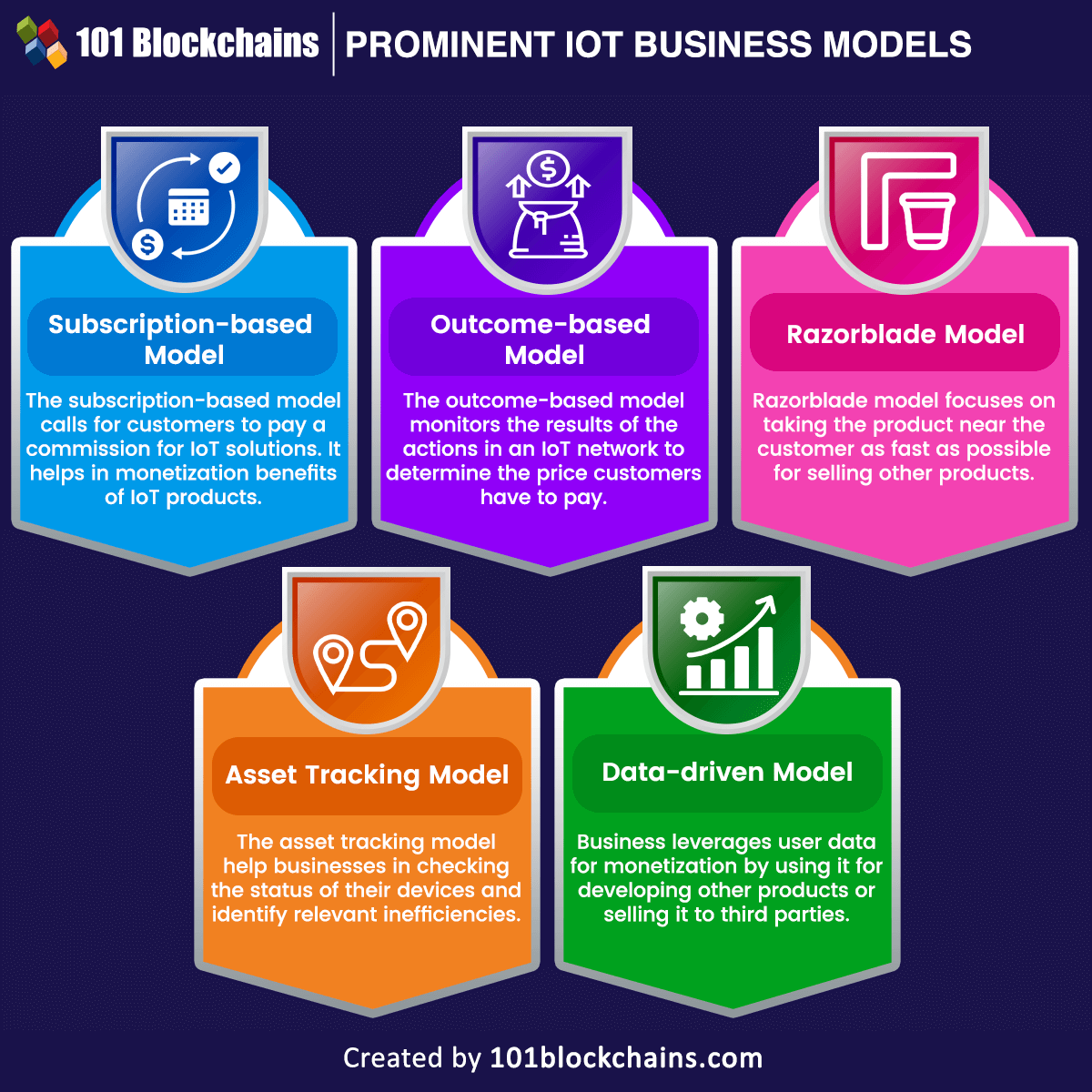
Please include attribution to 101blockchains.com with this graphic. <a href='https://101blockchains.com/blockchain-infographics/'> <img src='https://101blockchains.com/wp-content/uploads/2023/02/Prominent-IoT-business-models-1.png' alt='Prominent IoT business models='0' /> </a>
-
Subscription-based Model
The foremost answer to “What are the different business models for IoT?” would point to the subscription-based model. IoT solutions are constantly connected with internal and external customers, and the subscription-based plan could offer the chance to achieve a steady income. The subscription-based model calls for customers to pay a commission in return for continuous use of IoT solutions.
The subscription model helps the IoT solution in achieving many monetization benefits, limited primarily to software products. IoT businesses could use Software as a Service or SaaS models for creating their business model for IoT and identifying creative ways for monetization of their IoT product. The foremost advantage of such business models of IoT solutions points to opportunities for developing active relationships with customers.
-
Outcome-based Model
The next popular choice for a successful IoT business model is the outcome-based business model. Customers would pay for the outcome or the benefits of the IoT product. The outcome-based model monitors the results of the actions in an IoT network to determine the price customers have to pay. Businesses could explore creative opportunities for monetization through the implementation of outcome-based business models in the domain of IoT.
Want to learn how you can use blockchain in the Internet of Things (IoT)? Enroll in Getting Started with Blockchain And IoT Course Now!
-
Razorblade Model
The Razorblade model for IoT businesses relies on complementing the sale of other solutions. The primary goal of the razorblade model focuses on taking the product near the customer as fast as possible for selling other products. Such business models target the sales of more disposable products, where consumables need consistent replacement. Imagine an IoT solution that could reorder consumables when a device needs them. For example, a printer orders ink cartridges when it runs out of cartridges.
-
Asset Tracking Model
The best practices to create IoT business model also draw attention to the asset tracking model. Each connected device in the IoT network could help in identifying, controlling, and tracking assets in real-time. As a result, businesses can use IoT in the supply chain to safeguard assets from loss or theft. At the same time, real-time asset tracking can also support businesses with the advantages of proactive maintenance. The asset tracking model could also help businesses in checking the status of their devices and identify relevant inefficiencies.
-
Data-driven Model
The data-driven model is another popular example among IoT business models. It relies on the monetization of data collected by IoT devices. You can find answers to “What are the different business models for IoT?” by reflecting on the functionalities of the data-driven model. Businesses create an IoT solution that can offer value to customers. In return, the business leverages user data for monetization by using it for developing other products or selling it to third parties.
Furthermore, you can explore details of other business models recommended for IoT-based business ideas and check their feasibility. Remember that every IoT business has its unique requirements and must rely on different IoT business models.
Curious to know about learning resources for blockchain IoT? Check the detailed guide Now on What’s The Best Blockchain IoT Skill Path For Me?
How Will You Create an IoT Business Model?
The existing examples of IoT-based business models provide distinct insights into developing your own business model. However, it is important to note that you cannot come up with an innovative business model from nothing. You need to follow a comprehensive step-by-step design process to create IoT business model according to your needs. The five distinct steps in designing your business model for IOT include Setup, Discovery, Designing, Validation, and Decision. Here is an explanation of what you have to do in each step of designing business models for IoT implementations.
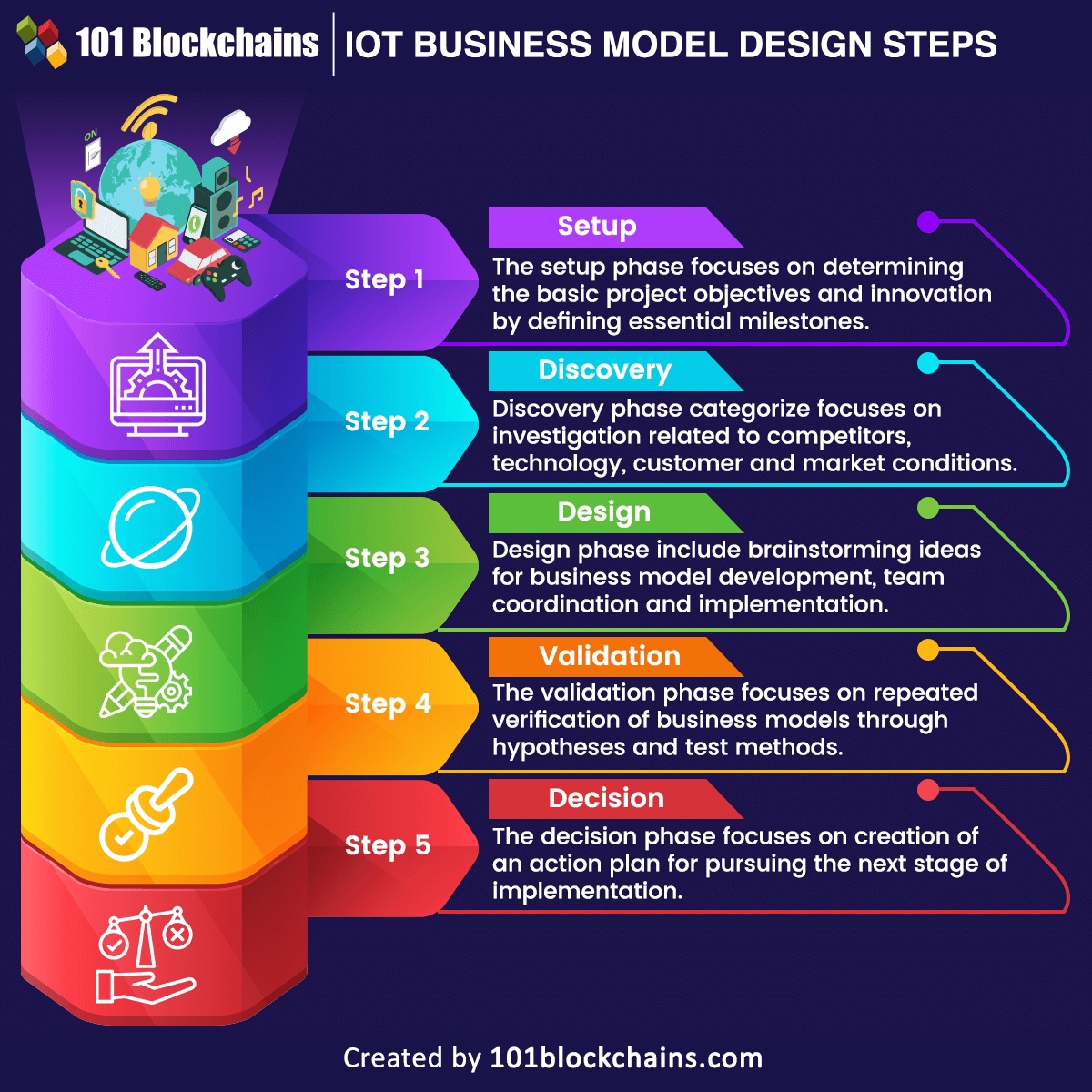
Please include attribution to 101blockchains.com with this graphic. <a href='https://101blockchains.com/blockchain-infographics/'> <img src='https://101blockchains.com/wp-content/uploads/2023/02/Steps-to-design-IoT-business-models.png' alt='IoT business models design steps='0' /> </a>
-
Setup
The setup phase is the foremost requirement for creating business models for IoT companies. Businesses must find an internal sponsor for their project to ensure advocacy for required resources and flexibility. At the same time, businesses must assemble a diverse, interdisciplinary project team that would dedicate their efforts completely to the project. The setup phase also focuses on determining the basic project objectives and focus on innovation. In addition, the first step of creating your IoT business model emphasizes the definition of essential milestones.
-
Discovery
The second step in creating business models for IoT businesses would be the discovery phase. You can create a successful IoT business model only by gathering the necessary information. Businesses must prioritize areas of examination, including competitors, technology, customer, and market conditions. It is important to categorize teams into different aspects of the investigation to broaden their expertise.
-
Design
The third step in creating business models of IoT businesses focuses on design. What is the primary objective of designing IoT solutions? Successful business models for IoT companies would emphasize the resolution of the pain points of customers. The most important requirements in the design phase include brainstorming ideas for business model development and team coordination. Businesses must transform ideas into real business models and implement them, followed by employing repeated testing.
-
Validation
The validation phase is important to create IoT business model based on repeated verification of business models through hypotheses and test methods. According to the degree of development and scale of the project, businesses must use different test methods for the validation of business models.
-
Decision
The final step in the development of your IoT business model would focus on decision-making. You should use the test results from the validation stage for comparing different business model ideas. Finally, you can create an action plan for pursuing the next stage of implementation.
Want to know how blockchain can benefit the IoT sector? Check the presentation Now on Blockchain With IoT – Top Blockchain IoT Use Cases
Bottom Line
The detailed introduction to “What are the different business models for IoT?” and the steps for creating your business model provide crucial inputs for your IoT business. One of the common misconceptions about IoT businesses is that you can stick an IoT sensor to an existing product and create an IoT business.
However, it is important to verify whether the IoT solution can deliver long-term value. The comprehensive planning of your requirements, brainstorming of different ideas, and validation of business models can ensure a successful business model for IoT-based businesses. Learn more about using IoT for businesses in detail now.




